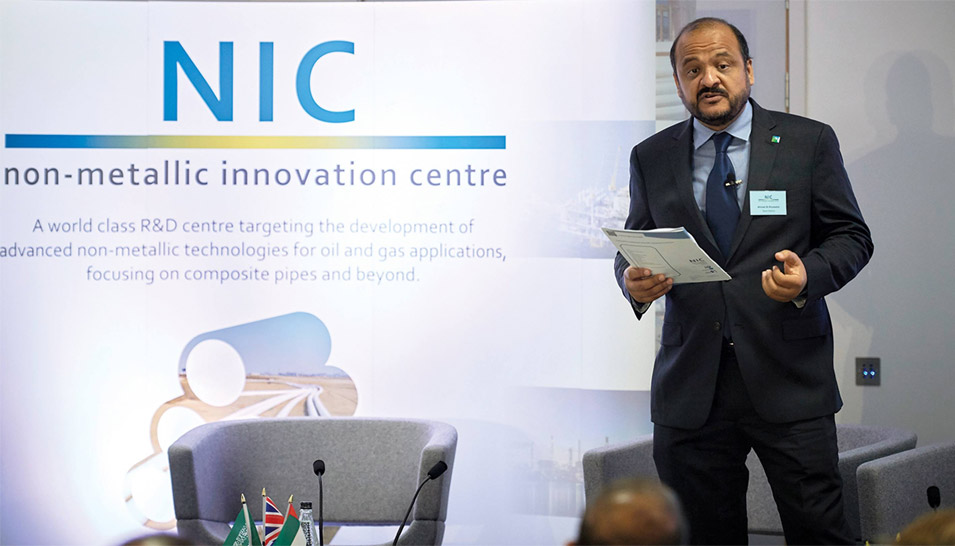
During the inauguration of the Nonmetallic Innovation Center in Cambridge, Ahmad O. Al-Khowaiter noted that the facility will help advance tools to combat the approximately $2.5 trillion it costs to treat pipelines and equipment across the oil and gas industry.
Saudi Aramco Technologies Company (AramcoTech), and the Abu Dhabi National Oil Company (ADNOC) on Monday officially opened the Nonmetallic Innovation Center (NIC) — a research center focused on innovation and advancing the use of nonmetallic industrial applications.
The launch of NIC will play an important role in advancing nonmetallic solutions across industries. The center is based at TWI in Cambridge and will develop technologies for new nonmetallic pipeline solutions.
Nonmetallics are increasingly deployed across multiple industries including oil and gas, construction, automotive, packaging and renewable. They combine several benefits as they are corrosion-resistant, lightweight and durable.
“Nonmetallic materials, especially in the oil and gas industry, are key to maintaining the integrity and safe and reliable operation of our facilities and providing protection from corrosion damage,” said Ahmad O. Al-Khowaiter, chief technology officer with Saudi Aramco. Al-Khowaiter told attendees at the inauguration that the cost of corrosion across all sectors worldwide was estimated the costs due to maintenance, repairs, and shutdowns are approximately $2.5 trillion.
“Such risks and costs can be significantly reduced by using corrosion management best practices, including the deployment of nonmetallic materials where applicable. These materials have demonstrated outstanding corrosion resistance due their chemical nature that does not support the electrochemical processes driving corrosion,” he noted.
“By bringing together TWI, AramcoTech, and ADNOC to set up NIC, we can be assured of producing industry-led research for the complete supply chain from research and development to production,” said NIC program director Mihalis Kazilas.
“NIC combines academia and industry so that there is a continuous chain between universities producing high-level research and industries that require academic-level analysis for real world applications,” Kazilas said.
Important Initiative
“We are delighted to be part of this important initiative,” said Ahmad O. Al-Khowaiter, chief technology officer with Saudi Aramco.
“The center will promote the utilization of advanced polymeric materials by conducting research that addresses challenges in their development and use,” Al-Khowaiter said. “This initiative is part of Saudi Aramco’s efforts to leverage our extensive hydrocarbon resources and technology development capabilities to deliver solutions that meet the world’s needs in a sustainable way.”
Dr. Alan Nelson, chief technology officer with ADNOC, said, “Nonmetallic solutions are continuing to reshape industries around the world. “From cost-efficient and durable pipelines to lightweight car designs, this technology has abundant science and engineering uses. In line with our Oil and Gas 4.0 mission, ADNOC is dedicated to leading and advancing this technology. Accelerating growth in new nonmetallic applications also creates new markets for crude and refined products. We are excited to partner with TWI and AramcoTech to help drive cutting-edge nonmetallic solutions for the oil and gas industry and beyond,” Nelson said.
Al-Khowaiter called for closer interactions with manufacturers and research centers to expand collaborations — inviting key players in the area to the join the center as research sponsors.
The inauguration also included a panel discussion on the “Future of Plastic and Composite Pipeline Technologies” with representatives from TWI, AramcoTech, ADNOC, Baker Hughes, and Soluforce.
NIC is a part of the Private Technology Innovation Partnerships initiative at TWI, working to address technology priorities, fostering open innovation, and commercialization of technology with sponsors and supply chain.
The center conducts a research program that covers Technology Readiness Levels 1 through 9, with partners being drawn from leading academic institutions, research centers, and composite material manufacturers.